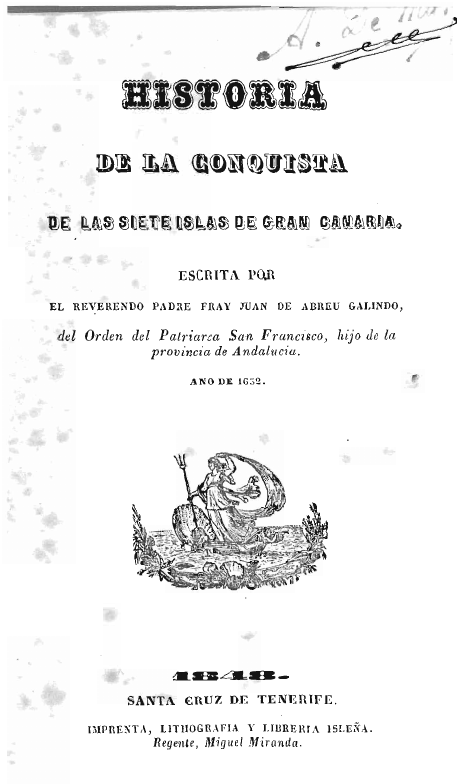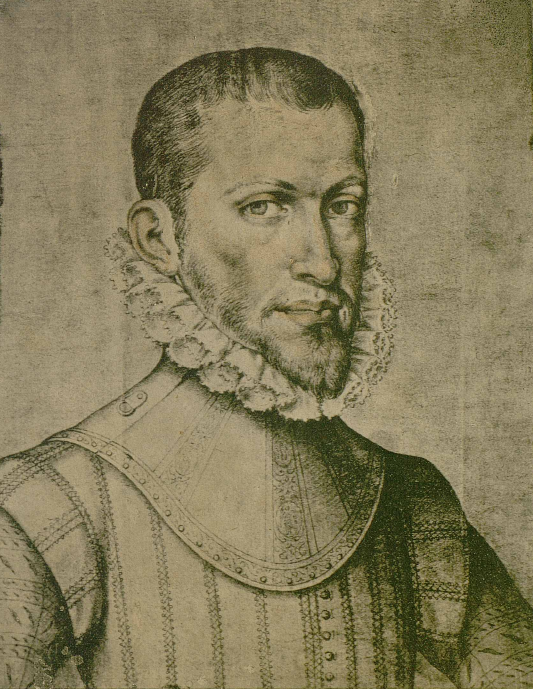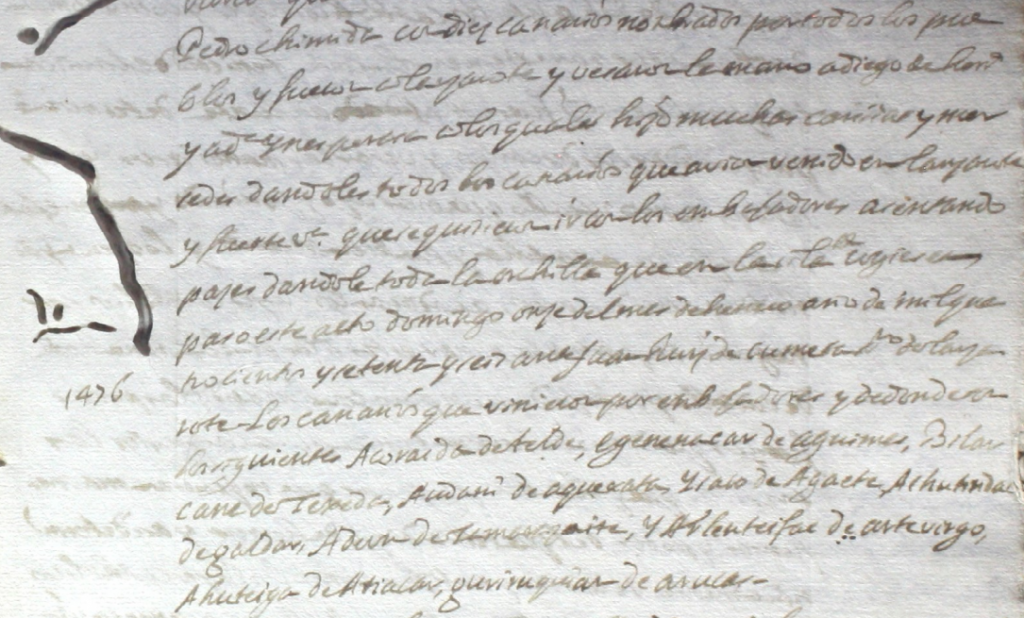
Front cover of the 1848 edition of the History of the Conquest of the Seven Islands of Gran Canaria, by Brother Juan de Abreu Galindo (source: Memoria Digital de Canarias).
It is true that many have claimed telling something about these islands; but they chose whatever suited their matter, and some of them, not having full news about, went brief and although what they said was very little, […] it has been a great argument to mean that not so low karats was the renown of the Isles of Canaria […].
Brother Juan de Abreu Galindo (Prologue to the History of the Conquest of the Seven Islands of Gran Canaria) –1848 Edition–
Leaving little room for doubt, this is perhaps the best known and influential work of the Canarian historiography.
(Post extended and amended on 10 December 2023)
Probably written in the late sixteenth century by Juan de Abreu Galindo, an alleged Andalusian Franciscan friar, opus known as History of the Conquest of the Seven Islands of Gran Canaria has the honor of being the first known scholar work dealing with the Ancient History of the Canary Islands. This is so because its author unfolds a vast and masterful knowledge in each of its pages, not only about the treated subject matter, but also on Greek and Roman classics such as Pliny the Elder, Solino or Tolomeo, as well as other more or less contemporaries authors as Pedro de Luján and Antonio de Nebrija, from whom the author compile their references to the Archipelago. In view of the additional information it offers, unpublished at the time, Abreu Galindo must have been undoubtedly a person who enjoyed privileged access to various files of utmost importance, emphasizing among all those belonging to the Herrera-Peraza family, last holders of the Seigneury of the isles of Canaria.
We are, in fact, facing a first and authentic history of the Archipelago, since the work is not only devoted to describe in detail the diachrony of the Conquest, enriching the contribution of the early chronicles by incorporating remarkable stories about specific events, but it also offers an extensive and valuable ethnographic account on the indigenous world, being a common reference for later studies. Plus the alleged friar’s History includes detailed descriptions of the Canarian geography, ending with a curious dissertation on the existence of the mythical island of Saint Brendan.
However, it should be noted that the Baroque flavor of Abreu Galindo’s work sometimes plays against its veracity, as the author tends to idealize the circumstances in which some passages take place. For example, the friar makes the final confrontation between Canarian warrior Doramas and Castilian governor Pedro de Vera a single combat between equals with a former’s voluntary conversion to Christianity during his agony after being mortally wounded by the Jerez-born knight, when other sources claim this clash was merely a dogfight skirmish between both sides’ armies, and in which Doramas could only be knocked down by a simultaneous attack of a number of both mounted and foot men. Another similar case of historical distortion by the alleged Franciscan it is to attribute the union between the Portuguese captain Diogo da Silva and María de Ayala, daughter of the Lord and Lady of the Canaries, as a result of a sudden infatuation of the former, when most of the audience witnesses in the Cabitos’ Inquiry claimed that consort Lord, Diego García de Herrera, had given the hand of his daughter to Silva as a ransom for getting back the Tower of Gando, as this fortress had fallen into the hands of the Portuguese during his attack on the Seigneury’s possessions probably in either the late 1460s or early 1470s.

Gonzalo Argote de Molina, portrayed by painter Francisco Pacheco, Velázquez’s teacher, in his Book of description of true portraits of memorable and famous men. This Sevillian is one of the candidates to embody the true identity of Brother Juan de Abreu Galindo (source: Biblioteca Virtual Andalucía).
Abreu Galindo: an author’s mystery
The uniqueness of the work of Brother Juan de Abreu Galindo increases when we admit not only that we hardly know anything about the author’s biography, besides the limited data he desired to reveal –an Andalusian Franciscan friar, student to humanist Francisco de Támara–, but it is quite possible that the alleged priest concealed his true identity.
Indeed, no trace has been found of the existence of the friar in any public or private, secular or priestly record, by the time he supposedly lived in. To the absence of any official data, the silence of other contemporary Canarian Franciscan authors who fail to mention in their works any colleague who were writing a history of the Conquest has to be summed up; but also Abreu Galindo himself, being a member of the Order of St. Francis by his own testimony, never comes to express himself as such throughout his history. In fact, references to his alleged profession suffer from certain self-referential remoteness, being those more by a secular than by a priest. [1]See CEBRIÁN (2007), pp. 110-113.
In relatively recent times it has come to the conclusion that Juan de Abreu Galindo is the pseudonym of an author interested in hiding his true identity, being a person of high cultural level, an expert in genealogy and skillful in handling files, who must have died before the attack and occupation of the city of Las Palmas de Gran Canaria by the Dutch navy of Vice Admiral Pieter van der Does, raid that took place in 1599 and, despite its notoriety, was not recorded in the history of the alleged Franciscan friar.
Among the names likely to embody the true identity of the Friar two stand out: that of Alonso Fiesco, a doctor from Cádiz, proposed by Professor José Barrios García and that of Sevillian scholar Gonzalo Argote de Molina, defended by researcher José Antonio Cebrián Latasa (Zaragoza, 1942 – Santa Cruz de Tenerife, 2007), who merely developed a hypothesis more than twenty years earlier by Dr. Lothar Siemens Hernández.[2]See BARRIOS (1995) -out of a congress held in 1989-, CEBRIÁN LATASA (2008) and SIEMENS (1988-1991), showing the latter a curious anagram relationship between the names Argote de Molina and Abreu Galindo. Apart from that, Cebrián Latasa provided the possibility that the alleged pseudonym named a team made up by Argote de Molina and Luis Melián de Betancor, a lawyer from Gran Canaria, signer of another work, smaller in terms of size but not in terms of its value: The Origin of the Islands of Canaria [3]See BARRIOS (1995), pp.122-124, and CEBRIÁN (2008), pp 46-51. Another hypothesis about the true person of our author dates from 1995, proposed by Romanian professor Alejandro (Alexandre) Cioranescu (Moroeni, 1911 – Santa Cruz de Tenerife, 1999), who defended that Abreu Galindo was the secular name of Brother Juan de San Francisco, provincial of the Franciscan Order in the Canary Islands around 1560-1563 [4]CIORANESCU (1995). , and of whom we know that he had in his possession at least one manuscript of the chronicle of the conquest of Gran Canaria attributed to Alonso Jáimez de Sotomayor, ensign major of the campaign, a conclusion also reached in 2004 by Professor Antonio Rumeu de Armas (Santa Cruz de Tenerife, 1912 – Madrid, 2006), without mentioning the precedent of Cioranescu[5]RUMEU DE ARMAS (2004)..

Excerpt of the copy made by Bachelor Juan Núñez de la Peña (17th-18th centuries) of the History by Brother Juan de Abreu Galindo, recently restored and preserved in the Centro de Documentación de Canarias y América (CEDOCAM) in San Cristóbal La Laguna, Tenerife (source: CEDOCAM).
The manuscripts
Of the original work of Abreu Galindo, whose final destination is unknown, we only have at present a number of copies made between the seventeenth and eighteenth centuries that have certain differences in their composition, of which the following are located nowadays: [6]BARRIOS (1995), pp 114-121; CEBRIÁN (2008), p 29.
- LACUNENSIS COPY (17th century, Biblioteca de la Universidad de La Laguna, catalogue number Ms. 42 (3)):
- Titleless, unfinished manuscript lacking some folios.
- Copyist unknown.
- Likely to be the oldest preserved copy.
- NÚÑEZ DE LA PEÑA’S COPY (17th-18th centuries, Centro de Documentación de Canarias y América, catalogue number FA CAN NUÑ 964):
- On the front cover: Conquista de las Canarias compuesta pr. fr. Juan de Abreu Galindo. esta escrita de letra de Juan Nuñez de la Peña, y lo q. le falta se lo llebó Dn. Jph Viera a quien presté este manuscrito [BROKEN] de su historia.
- Translation: Conquest of the Canaries composed b. Br. Juan de Abreu Galindo. it is written with letters of Juan Nuñez de la Peña, and what it lacks it was taken by Mr. Jph Viera to whom I lent this manuscript [BROKEN] of his history.
- Copy made by Tenerife Genealogist and Historian Juan Núñez de la Peña, mentioned by Barrios García and Cebrián Latasa,[7]BARRIOS (1995), p 115; CEBRIÁN (2008), pp. 28-29. reported by the latter as “missing” and “unreachable”.
- It was referred to us its recent recovery and preservation among the funds of the CEDOCAM by personal communication from Professor José Barrios García, who in turn had received these news from researcher Ángel Ignacio Eff-Darwich Peña during the celebration of the XXI Coloquios de Historia Canario-Americana (2014).
- Matching its title, in the digital copy we requested from the CEDOCAM, we have found that almost the entire Chapter IX and the beginning of Chapter X are missing from Book I while Book III misses the end of Chapter XXVI, folios which, according to the title page, must stayed kept in the hands of Enlightenment historian José de Viera y Clavijo.
- MARÍN DE CUBAS’ EXCERPT (17th. century, El Museo Canario Archive):
- An annotated summary-excerpt, contained in the so-called Marín Codex, written by Grandcanarian historian Tomás Marín de Cubas which would serve as notes for making his History of the Seven Islands of Canaria.[8]BARRIOS (2008).
- COPY AT THE BIBLIOTECA MUNICIPAL CENTRAL DE SANTA CRUZ DE TENERIFE (a. 1676, Biblioteca Municipal Central de Santa Cruz de Tenerife, catalogue number Ms. 191):
- Historia de la conquista de las siete Yslas de Gran Canaria escrita por el R. Pe. Fray Juan de Abreu Galindo del orden de el Patriarca San Francisco, hijo de la Provincia del Andalucía, año de 1632.
- Translation: History of the conquest of the seven Islands of Gran Canaria written by R. Fth. Brother Juan de Abreu Galindo of the order of Patriarch St. Francis, son of the Province of the Andalusia, year of 1632.
- Unfinished and probably prepared to be published.
- Written by two anonymous copyists.
- AMAT DE TORTOSA’S COPY (1775-1787, Biblioteca Municipal Central de Santa Cruz de Tenerife, catalogue number Ms. 5):
- Historia de la conquista de las siete Yslas de Canarias, escrita pr. el Rdo. Pe. F. Juan de Abreu Galindo del orden de S. Francisco, hijo de la Provincia de Andalucia. Año de 1632.
- Translation: History of the conquest of the seven Islands of the Canaries, written b. Rvd. Fth. Juan de Abreu Galindo of the order of St. Francis, son of the Province of Andalusia. Year of 1632.
- Unfinished copy by the hand of Lieutenant Colonel Andrés Amat de Tortosa.
The title of some of these copies point to 1632 as the year in which the alleged friar composed his History but, in view of the previously observed with respect to the attack of Van der Does on Las Palmas, it is obvious that year should be an error, unless we are willing to admit that Abreu Galindo was a real character who had left the Canaries before that aggression and who composed or finished his work off the Archipelago.
Recommended editions
Personally, we consider as highly recommended the acquisition and reading of the edition prefaced and annotated by Professor Alejandro Cioranescu in 1955, reprinted in 1977 and published by Goya Ediciones, being the latter available for digital borrowing. However, there are publicly, older editions, freely downloadable from Memoria Digital de Canarias:
- The 1848 edition published by Imprenta, Lithografía y Librería Isleña.
- The 1940 edition (incomplete) published by Imprenta Valentín Sanz.
It is also worth mentioning the English edition published in 1764 by the Scottish mariner and merchant George Glas, posthumously republished twice in 1767 in London and Dublin, which in reality is far from being a faithful and complete translation, but a sort of annotated synthesis of the work, but whose undeniable merit is that it is the first one through which the general public became aware of the existence of the extremely valuable work of our enigmatic friar.
Acknowledgements
From these lines we want to thank Professor José Barrios García for his valuable comments, amendments and suggestions regarding this post.
Antonio M. López Alonso
References
- Siemens Hernández, L. (1988-1991). Argote de Molina y Abreu Galindo: dos líneas paralelas que tienden a converger. El Museo Canario, 1(XLVIII):59–64.
- Barrios García, J. (1995). Abreu Galindo: una revisión necesaria. Con la transcripción de los fragmentos relativos a Lanzarote y Fuerteventura en un extracto inédito de finales del siglo XVII. In IV Jornadas de Estudios sobre Fuerteventura y Lanzarote, 1:112–137. Servicio de Publicaciones del Excmo. Cabildo Insular de Fuerteventura – Excmo. Cabildo Insular de Lanzarote.
- Cioranescu, A. (1995). Fray Juan de Abreu Galindo y el señorío de Canarias. Estudios Canarios: Anuario del Instituto de Estudios Canarios. núm. 39. pp. 135-146.
- Rumeu de Armas, A. (2004). Fray Juan de Abreu Galindo, historiador de Canarias. Anuario de Estudios Atlánticos. núm. 50. pp. 839-851.
- Barrios García, J. (2008). El microfilme Millares Carló (1934-1935). In Morales Padrón, F., editor, XVII Coloquio de Historia Canario-Americana, 1:314–322. Cabildo de Gran Canaria.
- Cebrián Latasa, J. A. (2008). Gonzalo Argote de Molina y su “Historia de Canarias” inacabada. Cartas diferentes. Revista canaria de patrimonio documental, 1(4):17–104.
